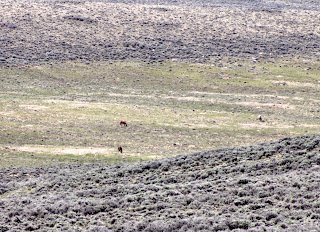How often have we seen Western movies that show wild horses running across the plains, free and living wild? Today we headed up into the high country to experience the Pilot Butte Wild Horse Scenic Tour Route where we hoped to see such a sight. Our chances were pretty slim since the area covers over 392,000 acres, but you never know just what wonders you might see.
All of it is overseen by the Bureau of Land Management. They are responsible for keeping watch on the herds and making sure they are healthy and sized so the environment can support them. About once a year, there is a roundup and horses are offered for adoption at a type of auction. The optimum total horse population is only around 250 horses -- guess our chance of seeing them was pretty slim. The horses’ history goes way back in time. 10,000 years ago, when many large mammals went extinct, the horses were among them. It was not until 1519 that the Spanish, led by Cortez brought horses back to North America. These horses were the birth of the herds that are seen here and all over the West today. Horses were very important to the Plains Indians as they gave them the mobility to roam farther to hunt and carry the load back to their villages or even move a village. White man depended on them as well for transportation and later, to transport mail via the Pony Express.
At one of the stops, instead of looking out across the valley, I looked the other way. There, deep in the rolling valley I could see horses! They were pretty much just tiny specks, but none the less there they were in the distance.
From that point, every hill we topped and every curve we rounded, we hoped to see more of them. It was not until nearly the end of the route did we finally get a close look.
As we topped a hill, there they were on both sides of the road. Beautiful.
All along the route are overlooks with information about the area including geological as well as human development of the land. In these hills, buttes and mesas are a wealth of minerals that we use in our every day lives. Coal mining is one of the major industries here and supports production of electricity. There is a vast network of power lines transporting electricity to ten states. The Bridger Mine transports coal through a 2.4 mile long covered belt conveyor to the Jim Bridger Power Plant. I makes me stop and think about where power comes from and how much work it takes when I flip a switch.
In addition to coal, the area produces natural gas, oil and Trona, among other things. I never heard of Trona before and had no idea what it was or what it was used to make. Turns out that Trona is found only in Africa, Turkey, China and Mexico. This area is the world’s major producer of Trona. Refined Trona is sodium carbonate which is found in laundry detergent, kitty litter, carpet cleaner, toothpaste, glass, paper and much, much more. There are several mines in the area that produce Trona and the reserves in the land holds enough to support the world’s needs for 2,000 years. Who would have thunk it?
To us, it was not what is under the land but just the land itself that draws us back time again to its beauty wherever it may be. Here, the formations of rock are colorful and show clear evidence of how the power of nature created this land. For example, long ago there was a huge lake called Gosiute in this valley. When compared to the Great Salt Lake, it was four times its size, massive. The lake supported all sorts of fish and animals and plant life. Volcanic activity in the areas of what is now California and Oregon spewed forth clouds of volcanic ash that covered the land and the lake over millions of years. It filled in the lake and preserved the fossils of the plants and animals. This area is one of the largest areas for the of collection of these fossils and provides a wealth of information for archaeologists.
We began the day wanting to see the horses who run free and wild in this area. At the end of the day, we came away with much more. We gained an understanding of how this land was formed and what it contains. While the horses are free and wild, so is the land. We cannot tame it, but we do draw from it precious minerals that gives us our way of life.






Stunning pictures and great narration...
ReplyDelete